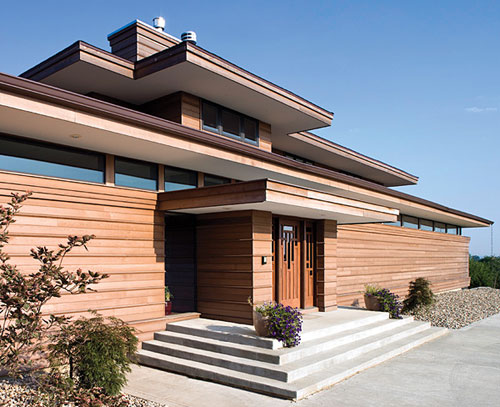Getting to Green: Life Cycle Analysis plus Forest Certification Give Western Redcedar High Marks in Sustainability
 "Every product will have some impact on the environment," says Draper. "What the LCA will do is to identify those products that use more resources, generate more pollution, waste or other unfavorable impacts than others, and in that way distinguish the products that are harmful from those that are reasonably environmentally sound. Manufacturers must identify the environmental footprint of their products. Currently, the best way to accomplish this is through an ISO-compliant LCA - that's the gold standard." Draper also notes as greenwash continues to proliferate and prescriptive standards unlikely to consistently lead the way to verifiable green standards, architects interested in specifying wood building materials that are sustainable may have a relatively clear-cut path. "In terms of specifying wood products, with forest certification and a favorable ISO-compliant life cycle analysis, you are well on your way to specifying a bona fide green product," says Draper.
 |
BRE, a UK-based independent and impartial research-based consultancy, testing and training organization, gave wall systems with western redcedar its top rating of A+ in its "Green Guide to Specification." Photo: Western Red Cedar Lumber Association |
Â
Western Redcedar Life Cycle Analysis
Western redcedar is one of the world's most thoroughly researched woods. A common tree in the Pacific Northwest coastal and interior rainforests of British Columbia, western redcedar is one of the longest lived and most decay- and insect-resistant softwood species in North America. It is light in weight, uniformly textured, straight-grained and contains no resin.
Western redcedar produces fewer greenhouse gases, generates less water and air pollution, requires less energy to produce than alternatives and comes from a renewable and sustainable resource. Equally important, western redcedar is carbon neutral. These assertions are borne out scientifically in the third-party LCA of siding and decking products commissioned by the Western redcedar Lumber Association (WRCLA) which determined that course to be the only credible way to provide consumers with reliable environmental performance information.
To place the study results in sharper perspective, a parallel study of alternative products including brick and fiber cement siding as well as composite decking products was also commissioned. FPInnovations, Canada's leading forest products research organization, conducted the study in accordance with international standards in the ISO 14040/44 series, which requires that all products be treated equally and be of similar quality. Study results were presented for peer review to independent third-party organizations to ensure ISO standards compliance.
For western redcedar products, the study was based on data obtained from a representative cross section of cedar mills in British Columbia and Washington state in 2007. The Athena Institute provided life cycle inventories (LCIs) for clay brick, fiber cement and vinyl siding. Cradle-to-grave LCIs for wood-plastic composite decking made with either virgin or reprocessed plastic were also developed using secondary data sources as well as information collected from experts in the petrochemical and wood-plastic composite fields.
In order to evaluate the environmental impacts of the life-cycle stages of product alternatives, the life cycle was modeled as four distinct life-cycle stages: resource extraction and manufacturing, transportation to customer, installation and use, and end-of-life disposition - an approach that helps identify where environmental contributions occur within the life cycle of each product system.









